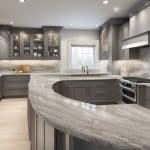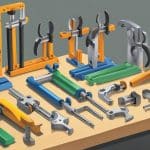Types Of Locks
Locks are an essential part of our daily lives, providing us with security and peace of mind. They come in various types, each with its own unique features, benefits, and drawbacks. Understanding the different types of locks available can help you choose the best one for your needs and ensure maximum security for your property.
The basic types of locks include padlocks, deadbolts, knob locks, and lever handle locks. Each of these locks operates differently and provides varying levels of security. Additionally, specialized lock types are available for specific applications, such as cabinet locks, luggage locks, and motorcycle locks. High-security lock options are also available for those who require extra protection against break-ins and theft.
Understanding the mechanisms and installation of locks is crucial for ensuring their proper operation and effectiveness. Lock security standards and grades are also important considerations when choosing a lock. By learning about the different types of locks and their features, you can make an informed decision when selecting the best one for your needs.
Key Takeaways
- There are various types of locks available, each with its own unique features and benefits.
- Understanding the mechanisms and installation of locks is crucial for ensuring their proper operation and effectiveness.
- Lock security standards and grades are important considerations when choosing a lock.
Basic Lock Types

When it comes to securing a property, the first line of defense is often the lock. There are several types of locks available in the market, each with its own set of features and benefits. In this section, we will discuss the most common types of locks, including padlocks, knob locks, cam locks, and deadbolt locks.
Padlocks
Padlocks are a type of lock that is not permanently attached to anything else. They are freestanding and portable, making them ideal for securing items such as lockers, toolboxes, and gates. Padlocks come in various shapes and sizes, and they can be keyed or combination-based.
Keyed padlocks require a key to unlock, and they offer a basic level of security. Shrouded padlocks offer additional security by covering the shackle, which makes it difficult for bolt cutters to cut through. Key-retaining padlocks are designed to prevent the key from being removed while the padlock is open, which helps to prevent accidental lockouts.
Knob Locks
Knob locks are commonly found on residential doors. They are installed on the surface of the door and have a knob on one side and a keyhole on the other. Knob locks are not the most secure type of lock, as they can be easily picked or forced open. However, they are easy to install and use.
Cam Locks
Cam locks are light-duty locks commonly used to secure cabinets, drawers, and other small compartments. They have a cylindrical base with a keyhole and a metal latch called the cam. The cam rotates when the key is turned, which locks or unlocks the cabinet or drawer. Cam locks are not the most secure type of lock, but they are easy to install and use.
Deadbolt Locks
Deadbolt locks are the most secure type of lock and are commonly found on residential and commercial doors. They are installed on the surface of the door and have a bolt that extends into the door frame. Deadbolt locks come in two types: single-cylinder and double-cylinder.
Single-cylinder deadbolt locks require a key to unlock from the outside and have a thumb turn on the inside. Double-cylinder deadbolt locks require a key to unlock from both the inside and the outside. Double-cylinder deadbolt locks offer additional security but can be a safety hazard in the event of an emergency, as they can make it difficult to exit the property quickly.
In conclusion, when it comes to choosing a lock, it is important to consider the level of security required, the ease of use, and the cost. Each type of lock has its own set of features and benefits, and it is up to the property owner to determine which type of lock is best suited for their needs.
Specialized Lock Types
When it comes to securing doors, there are a variety of lock types to choose from. Some of the most common lock types include mortise locks, cylinder locks, and lever handle locks. Each of these lock types has its own unique features and benefits.
Mortise Locks
Mortise locks are a type of lock that is typically used for exterior doors. These locks are installed within the door itself, rather than on the surface of the door. This makes them more secure than other types of locks, as they are more difficult to pick or tamper with. Mortise locks are also highly durable, and can withstand years of use without needing to be replaced.
Cylinder Locks
Cylinder locks are a type of lock that is commonly used for both interior and exterior doors. These locks feature a cylinder-shaped mechanism that is inserted into the door, and can be turned with a key to lock or unlock the door. Cylinder locks are highly versatile, and can be used in a wide range of applications. They are also relatively easy to install and maintain, making them a popular choice for homeowners and businesses alike.
Lever Handle Locks
Lever handle locks are a type of lock that is commonly used for interior doors. These locks feature a lever-shaped handle that is used to open and close the door. Lever handle locks are particularly useful for people with mobility issues, as they are easier to operate than other types of locks. They are also highly secure, and can be customized with a variety of security features to meet the needs of any home or business.
When choosing a lock for your home or business, it is important to consider factors such as the type of door you are securing, the level of security you require, and the features you need. By selecting the right lock type and door hardware, you can ensure that your property is protected from intruders and other security threats. Additionally, it is important to choose a lock that is rated for the appropriate level of security. Lock grades range from Grade 1 (the most secure) to Grade 3 (the least secure), so it is important to choose a lock that meets your specific needs.
High-Security Lock Options
When it comes to ensuring maximum security, high-security locks are the way to go. These locks are designed to provide the utmost protection against burglars, thieves, and other intruders. High-security locks come in various types, including electronic locks and smart locks.
Electronic Locks
Electronic locks are a popular type of high-security lock. They provide keyless entry and are operated using a keypad or a remote control. Electronic locks are designed with advanced encryption technology that makes it difficult for hackers to gain access to the system. They are also equipped with a backup battery that ensures the lock remains functional even during power outages.
Smart Locks
Smart locks are another type of high-security lock that is gaining popularity among homeowners. These locks are equipped with advanced technology that allows remote access through a smartphone or a fingerprint scanner. Smart locks are also designed with biometric technology that ensures only authorized users can gain access to the system.
In conclusion, high-security locks are an essential investment for anyone looking to secure their home or business. Electronic and smart locks are two popular options that provide maximum security and convenience. It is important to choose a lock that meets your specific needs and budget.
Locks for Specific Applications
Furniture and Cabinets
Furniture and cabinets often require a specific type of lock to keep their contents secure. One popular type of lock for furniture and cabinets is the cam lock. Cam locks are easy to install and come in a variety of sizes to fit different applications. They are commonly used on file cabinets, desk drawers, and other types of furniture.
Another option for furniture and cabinets is the plunger lock. Plunger locks are often used on sliding doors and are designed to be easy to install and use. They are also commonly used on display cases and other types of furniture where the lock needs to be hidden.
Mail and Delivery
When it comes to mail and delivery, there are a few different types of locks that can be used. One common type of lock is the wall mounted lock. Wall mounted locks are often used on mailboxes and are designed to be durable and secure. They are typically made from heavy-duty materials and can withstand harsh weather conditions.
Another option for mail and delivery is the key-retaining lock. Key-retaining locks are designed to keep the key in the lock when it is unlocked. This ensures that the lock is always secure and prevents the key from being lost or stolen. Key-retaining locks are often used on mailboxes, delivery boxes, and other types of secure storage containers.
Overall, there are many different types of locks that are designed for specific applications. Whether you need a lock for your furniture, cabinets, or mail and delivery, there is a lock that will meet your needs. By choosing the right type of lock for your specific application, you can ensure that your belongings are always secure and protected.
Understanding Lock Mechanisms and Installation
Cylinder and Bolt Mechanism
Locks work by using a combination of a cylinder and bolt mechanism. The cylinder is the part of the lock where the key is inserted, and it interacts with the lock’s internal components. The bolt is the part of the lock that extends into the door frame, preventing the door from being opened.
The cylinder mechanism is made up of several small pins that line up with the cuts on the key. When the correct key is inserted into the cylinder, the pins align, allowing the cylinder to turn and retract the bolt.
The bolt mechanism is made up of two parts: the latch bolt and the deadbolt. The latch bolt is the part of the bolt that extends into the door frame and keeps the door closed. The deadbolt is an additional bolt that extends further into the door frame, providing extra security.
Installation and Maintenance
Proper installation and maintenance of locks are crucial for home security. When installing a lock, it is important to consider the backset, which is the distance between the edge of the door and the center of the lock. The backset should be measured before installing the lock to ensure that it fits properly.
Maintenance of locks includes regular cleaning and lubrication of the internal components. Strike plates should also be checked for proper alignment and attachment to the door frame.
Rekeyable padlocks are a popular option for those who want to easily change the key without replacing the entire lock. These locks can be rekeyed by the owner using a special tool.
In summary, understanding the cylinder and bolt mechanism of locks and proper installation and maintenance are key factors in ensuring home security. Regular cleaning, lubrication, and checking of strike plates are essential for maintaining the functionality of locks. Rekeyable padlocks offer a convenient option for those who want to easily change the key without replacing the entire lock.
Lock Security Standards and Grades
ANSI/BHMA Standards
The American National Standards Institute (ANSI) and the Builders Hardware Manufacturers Association (BHMA) have established standards for lock security. These standards are designed to ensure that locks are strong and durable enough to provide adequate security for their intended use.
The ANSI/BHMA standards cover a range of factors that contribute to lock security, including material evaluation, thickness, strength, and security. The standards also include tests for operational performance, cycle testing, and finish durability.
Lock Grades Explained
The ANSI/BHMA lock grading system provides an indication of the quality and strength of a lock. The system is composed of three lock grades: Grade 1, Grade 2, and Grade 3.
-
Grade 1 locks are the strongest and most durable locks available. These locks are designed for commercial/high-security use and must meet strict performance standards. They must withstand 800,000 cycles of operational testing, a 360-pound weight test, and six door strikes.
-
Grade 2 locks are suitable for light commercial/heavy residential use. They must withstand 400,000 cycles of operational testing, a 250-pound weight test, and five door strikes.
-
Grade 3 locks are designed for residential use and must meet basic performance standards. They must withstand 200,000 cycles of operational testing, a 150-pound weight test, and two door strikes.
The ANSI/BHMA lock grading system is an important tool for consumers who want to ensure that they are purchasing a lock that provides adequate security for their needs. By choosing a lock that meets the appropriate grade level, consumers can be confident that their property is protected.






